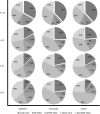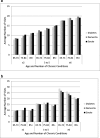Insights on multimorbidity and associated health service use and costs from three population-based studies of older adults in Ontario with diabetes, dementia and stroke
- PMID: 31096989
- PMCID: PMC6524233
- DOI: 10.1186/s12913-019-4149-3
Insights on multimorbidity and associated health service use and costs from three population-based studies of older adults in Ontario with diabetes, dementia and stroke
Abstract
Background: Most studies that examine comorbidity and its impact on health service utilization focus on a single index-condition and are published in disease-specific journals, which limit opportunities to identify patterns across conditions/disciplines. These comparisons are further complicated by the impact of using different study designs, multimorbidity definitions and data sources. The aim of this paper is to share insights on multimorbidity and associated health services use and costs by reflecting on the common patterns across 3 parallel studies in distinct disease cohorts (diabetes, dementia, and stroke) that used the same study design and were conducted in the same health jurisdiction over the same time period.
Methods: We present findings that lend to broader Insights regarding multimorbidity based on the relationship between comorbidity and health service use and costs seen across three distinct disease cohorts. These cohorts were originally created using multiple linked administrative databases to identify community-dwelling residents of Ontario, Canada with one of diabetes, dementia, or stroke in 2008 and each was followed for health service use and associated costs.
Results: We identified 376,434 indviduals wtih diabetes, 95,399 wtih dementia, and 29,671 with stroke. Four broad insights were identified from considering the similarity in comorbidity, utilization and cost patterns across the three cohorts: 1) the most prevalent comorbidity types were hypertension and arthritis, which accounted for over 75% of comorbidity in each cohort; 2) overall utilization increased consistently with the number of comorbidities, with the vast majority of services attributed to comorbidity rather than the index conditions; 3) the biggest driver of costs for those with lower levels of comorbidity was community-based care, e.g., home care, GP visits, but at higher levels of comorbidity the driver was acute care services; 4) service-specific comorbidity and age patterns were consistent across the three cohorts.
Conclusions: Despite the differences in population demographics and prevalence of the three index conditions, there are common patterns with respect to comorbidity, utilization, and costs. These common patterns may illustrate underlying needs of people with multimorbidity that are often obscured in literature that is still single disease-focused.
Keywords: Community-living older adults; Comorbidity; Health service costs; Health service utilization; Multimorbidity.
Conflict of interest statement
The authors declare that they have no competing interests.
Figures




Similar articles
-
Comorbidity and its relationship with health service use and cost in community-living older adults with diabetes: A population-based study in Ontario, Canada.Diabetes Res Clin Pract. 2016 Dec;122:113-123. doi: 10.1016/j.diabres.2016.10.009. Epub 2016 Oct 20. Diabetes Res Clin Pract. 2016. PMID: 27833049
-
Patterns of health service use in community living older adults with dementia and comorbid conditions: a population-based retrospective cohort study in Ontario, Canada.BMC Geriatr. 2016 Oct 26;16(1):177. doi: 10.1186/s12877-016-0351-x. BMC Geriatr. 2016. PMID: 27784289 Free PMC article.
-
Multimorbidity and healthcare utilization among home care clients with dementia in Ontario, Canada: A retrospective analysis of a population-based cohort.PLoS Med. 2017 Mar 7;14(3):e1002249. doi: 10.1371/journal.pmed.1002249. eCollection 2017 Mar. PLoS Med. 2017. PMID: 28267802 Free PMC article.
-
[Effects of multimorbidity on health care utilization and costs].Bundesgesundheitsblatt Gesundheitsforschung Gesundheitsschutz. 2012 May;55(5):685-92. doi: 10.1007/s00103-012-1475-6. Bundesgesundheitsblatt Gesundheitsforschung Gesundheitsschutz. 2012. PMID: 22526857 Review. German.
-
Multimorbidity is common to family practice: is it commonly researched?Can Fam Physician. 2005 Feb;51(2):244-5. Can Fam Physician. 2005. PMID: 16926936 Free PMC article. Review.
Cited by
-
Conceptualising comorbidity and multimorbidity in dementia: A scoping review and syndemic framework.J Multimorb Comorb. 2022 Sep 27;12:26335565221128432. doi: 10.1177/26335565221128432. eCollection 2022 Jan-Dec. J Multimorb Comorb. 2022. PMID: 36187908 Free PMC article.
-
Prevalence and sequence of chronic conditions in older people with dementia: a multi-province, population-based cohort study.Health Promot Chronic Dis Prev Can. 2025 May;45(5):223-237. doi: 10.24095/hpcdp.45.5.01. Health Promot Chronic Dis Prev Can. 2025. PMID: 40402135 Free PMC article.
-
Development and feasibility of an inter-agency physical activity and education programme for adults with multimorbidity in primary care: Activ8.J Multimorb Comorb. 2022 Dec 9;12:26335565221142350. doi: 10.1177/26335565221142350. eCollection 2022 Jan-Dec. J Multimorb Comorb. 2022. PMID: 36518523 Free PMC article.
-
Self-management program versus usual care for community-dwelling older adults with multimorbidity: A pragmatic randomized controlled trial in Ontario, Canada.J Comorb. 2020 Oct 16;10:2235042X20963390. doi: 10.1177/2235042X20963390. eCollection 2020 Jan-Dec. J Comorb. 2020. PMID: 33117723 Free PMC article.
-
Why are older adults living with the complexity of multiple long-term conditions, frailty and a recent deterioration in health under-served by research? A narrative synthesis review of the literature.J Frailty Sarcopenia Falls. 2023 Dec 1;8(4):230-239. doi: 10.22540/JFSF-08-230. eCollection 2023 Dec. J Frailty Sarcopenia Falls. 2023. PMID: 38046442 Free PMC article. Review.
References
-
- Boyd CM, Fortin M. Future of multimorbidity research: how should understanding of multimorbidity inform health system design? Public Health Rev. 2010;32:451–474. doi: 10.1007/BF03391611. - DOI
-
- American Geriatrics Society Expert Panel on the Care of Older Adults with Multimorbidity Guiding principles for the care of older adults with multimorbidity: an approach for clinicians: American Geriatrics Society expert panel on the Care of Older Adults with multimorbidity. J Am Geriatr Soc. 2012;60:E1–E25. doi: 10.1111/j.1532-5415.2012.04188.x. - DOI - PMC - PubMed
-
- Farmer C, Fenu E, O'Flynn N, Guthrie B. Clinical assessment and management of multimorbidity: summary of NICE guidance. BMJ. 2016;354:i4843. - PubMed
MeSH terms
Grants and funding
LinkOut - more resources
Full Text Sources
Medical

